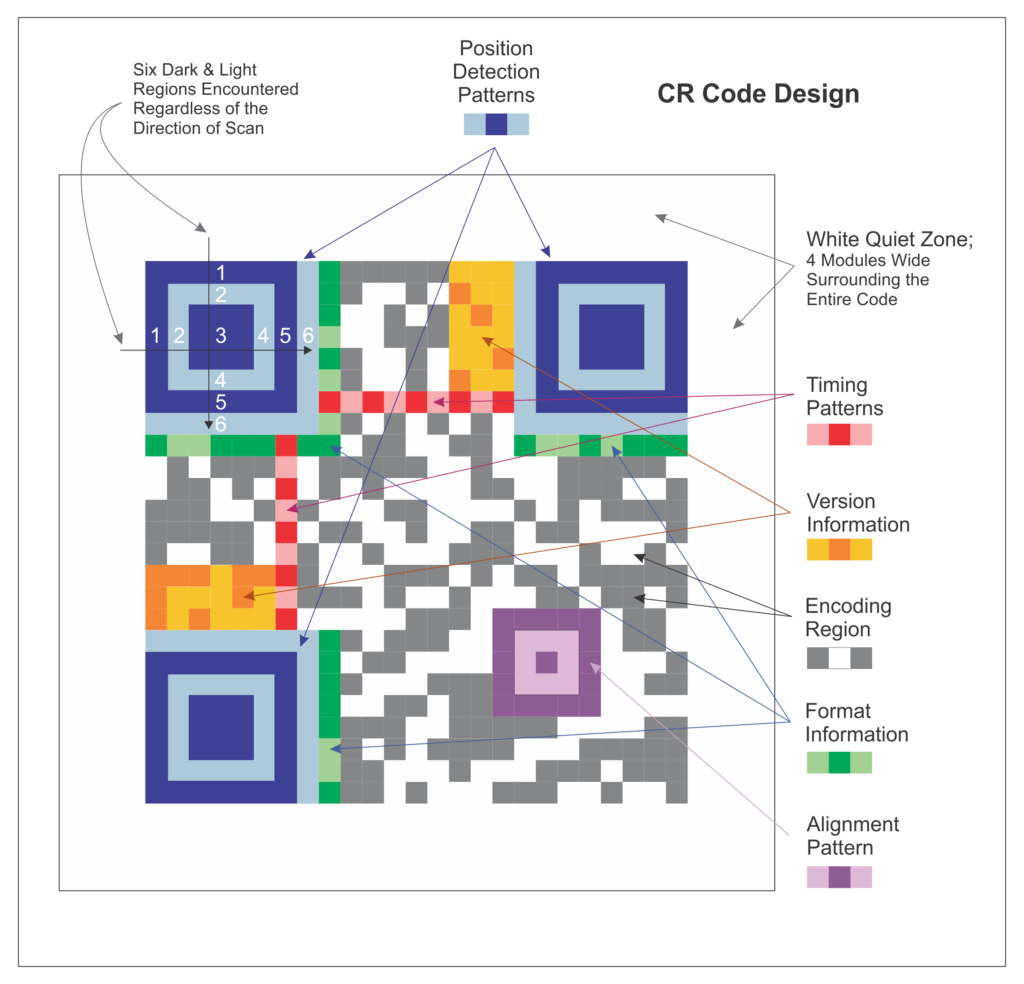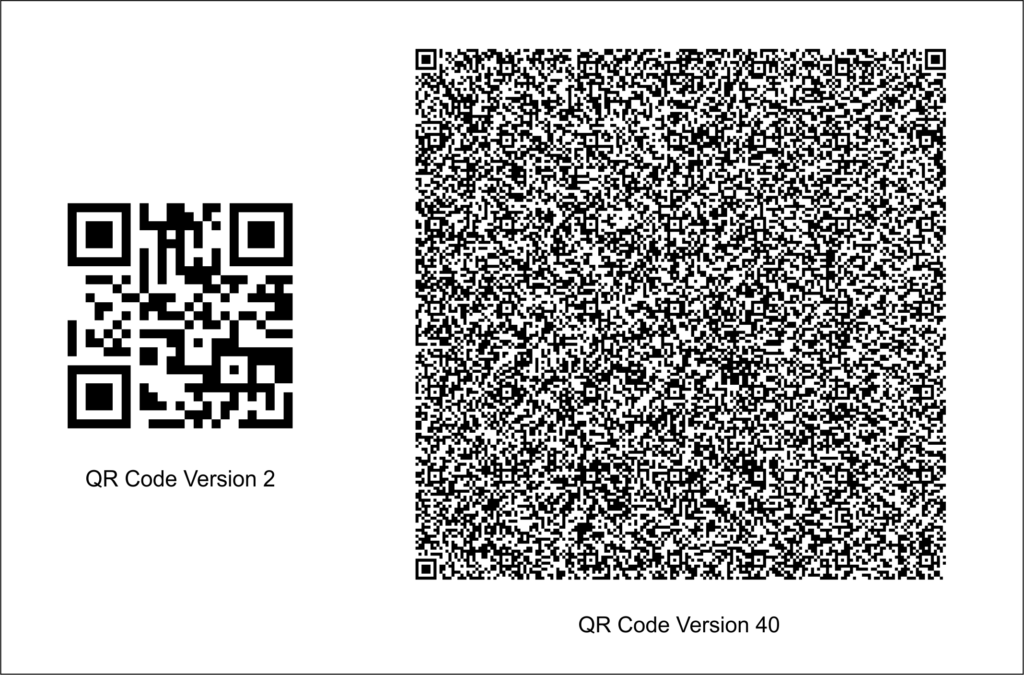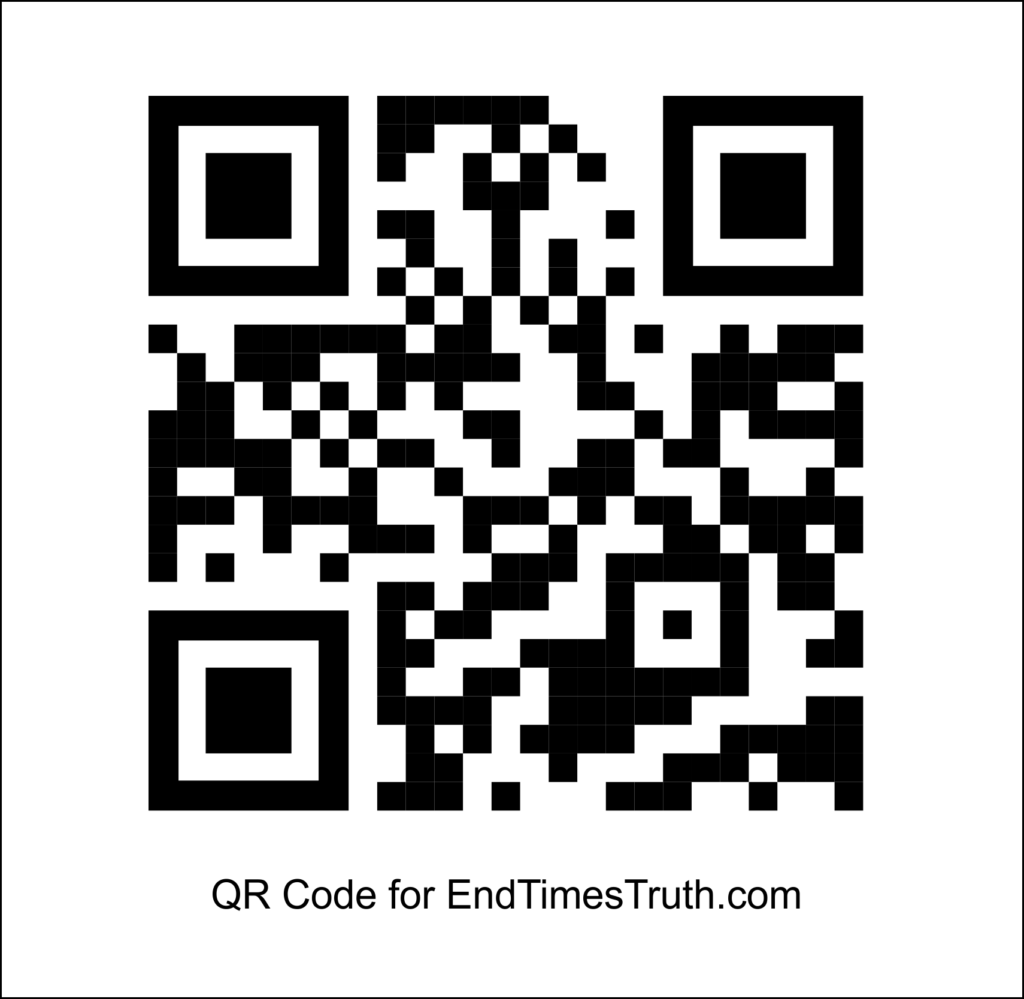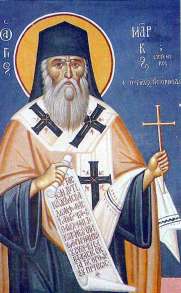
The Quick Response Code (or QR Code) is a type of digital barcode that has quickly gained in popularity in recent years. It was invented by a Japanese auto company (Denso-Wave) in 1994 to provide scanning of inventory parts used in manufacturing. The QR Code provides a 2-dimensional matrix of digital information that has significant advantages over single-dimensional codes, such as the UPC barcode.
The general design of the QR Code is shown in the illustration at the top. It normally consists of a series of black squares arranged in a grid or matrix on top of a white square background. The patterns that the white and black squares make within the QR Code represent the digital data that can be read by a camera or scanner. The illustration above has been annotated in colored light and dark regions to identify the major parts of the QR Code design, but normally the code would be only displayed in black and white.
The types of QR codes that are the most commonly used are the Model 1 and Model 2 designs. There are 40 different versions of these models, each with options for 4 different types of error correction code (ECC) built into the symbology. In general, the higher the QR Code version number, the more data that can be incorporated into it. The data density within a 2D code matrix is much greater than that possible with standard one-dimensional barcodes such as the UPC. In addition, multiple QR Codes can be used side-by-side to provide extended data if necessary.
The specification for the QR Code allows for the encoding of several different data types that may consist of numeric (numbers), alphanumeric (numbers and text), binary data (0’s and 1’s), and logographic languages, such as Kanji graphics used to write Japanese characters.
Each bit of data within the QR code is called a module. Version 1 of the code was made of a matrix of 21×21 modules, which allows for a maximal data capacity of 152 bits of mixed alphanumeric code. Version 40, however, is much larger and can accommodate up to 7,089 bits of the same mixed data type. The second illustration shows two versions of the QR Code and their data density differences. The use of several alignment patterns within the data plane is used with the larger versions to maintain reading integrity as the matrix is scanned.

Even larger capacity QR Codes have been developed for specialty applications. Some of these use colored data regions where bit depths using 4 or 8 different colors can identify additional digital information not possible with black and white codes alone.
There are many free and premium paid versions of QR Code generators available on the Internet as well as several apps that can facilitate the design of custom codes. The software allows input of the desired text or information string and the code is then automatically generated. The QR Code version and size that becomes the output is changed depending on the amount of information that is input. The finished code can then be downloaded as a vector image file for use at any scale on the web or in print. The QR Code seen here was generated as a link to theEndTimesTruth.com website using a free generator app.

666 Within the QR Code Design
Just as a pseudo-666 could be found within the design of the UPC Code (see the main section entitled 666), the QR Code incorporates a different type of pseudo-666 within its square matrix.
Where does this pseudo-666 occur? Each full-sized version of the QR Code contains 3 internal positioning marks (Position Detection Patterns) within its grid that are arranged at 3 of the 4 corners of the matrix. These marks indicate to a scanner which way the code was originally printed and therefore in what direction the data should be read and interpreted. Without these detection patterns, the QR Code might be read from any one of 4 different directions and it would return errors in data interpretation for the majority of scans.
The scanner software algorithm looks for these positioning markings and virtually orients the QR Code in processing so that the marks occur at both top corners as well as at the lower left side of the matrix. Once the code pattern is oriented in this way, the data can be read and interpreted properly. The position detection patterns thus allow the code to be read in a scanner from any orientation and the correct position identified in software to provide an accurate interpretation of the data.
Notice the unique design of the 3 positioning marks. They appear as a series of nested squares within squares. The outer square is actually present on only the inner two sides of each detection pattern and consists of a Separator region that isolates the positioning markings from the rest of the QR Code data.
Therefore, if we visually scan from the outside of any one of the Position Detection Patterns inward, we would first encounter an outer black region that is then followed by a white region, followed by a thick black square region at the center, followed by another white region, a black region, and finally the white separator region. As each of these positioning markings is read by a scanner, the scan can take place from any direction and the same data will be read for the position marks. Therefore, if you follow any straight path through the center of a detection pattern, to the eye it appears as 6 distinct white and black regions regardless of the direction scanned.
For instance, if the top left positioning mark in a QR Code is visually scanned—moving through it from any direction—then the light and dark regions encountered would be: black, white, thick black, white, black, white. Thus, regardless of the direction of the scan, we would move through 6 regions for each of the 3 positioning markings.
Now, do you see it? The standard form of the QR Code has 3 separate positioning marks each containing a visual set of 6 distinct black and white regions! The QR Code thus has a pseudo-666 design just as the UPC Code was found to have a pseudo-666 in its control patterns.
Some will say that this is not truly the number 666 and I agree. However, the visualappearance of the 666 design is indicative of the rise of the spirit of 666 within the world’s economic system. It was probably not planned to appear in this way by the designers of the QR Code; it just came about because of the prophetic times in which we live. The Number of the Beast is growing within the system of the Empire even before the Antichrist rises to power!
It is no coincidence that a pseudo-666 appears within the most popular barcodes used in commerce today. For decades, every product has been marked with a UPC code containing a pseudo-666 code and now every QR Code used in commerce contains a pseudo-666 as well.
The digital data scanned within the QR Code’s Position Detection Patterns, however, does not relate to the number 666, just as the digital data within the UPC control patterns doesn’t relate to the number 666. The actual computer-readable data in the QR Code positioning mark consists of one bit for the outer black box (one module wide), one bit for the inner white box (one module wide), 3 bits for the central thick black box (which is 3 times thicker than the black or white box borders or 3 modules wide), one bit for the other side of the white box, and finally one bit for the other side of the black box. Thus, scanning through a single positioning mark there are a total of 7 bits of data used to identify each pattern. The aspect of 666 appearing within the code is only seen visually, but not digitally.
The QR Code probably would have remained a minor variant of barcode design were it not for the development of smartphones. The rapid scanning capability of QR Codes by a smartphone allows them to become quick links to many sources of online information or for access to secure locations or services. The many uses of QR Codes include links to websites; product pages; WiFi networks; e-learning systems; vCards; instruction manuals or companion products; explanatory information about geographic or historical sites; mobile payment systems; obtaining information about drugs or consumer products; for links to e-commerce purchase pages; on poster ads for products; to obtain coupons or receipts; for ticketing, boarding passes, or to learn more about events or transportation; to unlock doors; for inventory management; to display restaurant menus; for attendance in classrooms, and most recently for displaying validated personal information.
It is that last application that is particularly troubling. As the world moves closer to a global system of governance, it appears that the QR Code will be used to display official government-mandated information about you. This type of information can be tied to your participation in certain aspects of society—an aspect that the government may deem to be a privilege and not a right.
I’ll soon post another article about this growing use for QR Codes in the display of personal information. This recent application relates directly to End Times prophecy and is a very real prelude to the Mark of the Beast.
Источник: https://endtimestruth.com/the-qr-code-and-the-number-of-the-beast/

